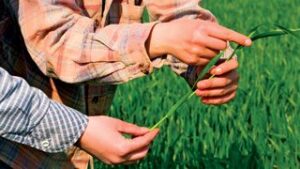Stacked traits are becoming the standard in today’s seed industry—but in order to sell them seed companies need to know what combination of multiple modes of control provide the best value.
How many traits are enough? Because of the rapidly accelerating world of biotechnology, this intriguing question has been perplexing more and more producers and, perhaps, seed industry professionals as well. As trait combinations become more complex, it is becoming more important for seed companies to fully understand the value behind the stacks before they can sell them to their customers.
Alan Gould of Verdant Partners says the right combination is a question of price versus value. “Obviously if the technology fee charged for stack of traits pushes the price of a bag of seed beyond the value of the harvestable yield, there are too many traits in the package. An indication that this situation is almost here is signalled by the fact that small numbers of growers are reverting to conventional (non-trait bearing) genetics,” he says. “This is because the difference between the price of a bag of conventional seed and a bag of seed with multi-trait stack is sometimes so great that using more traditional genetics and ag-chemical solutions provides a better return for some growers. Unfortunately the availability of conventional seed as a grower option has declined as multiple traits have become more popular.”
Ben Kaehler, traits and germplasm licensing leader with Dow AgroSciences, says it still comes down to each individual grower’s farm. “Asking the question, ‘How many traits are enough?’ infers a negative connotation about traits which is misleading,” he says. “Growers have many choices of hybrids which include their trait preference. If growers put high value on maximizing the protection of their crop, then there is value in stacking the traits giving that crop multiple modes of protective action. The protection, the durability, the convenience of having these traits stacked together is important.”
It makes sense that it comes down to return on investment, and Irv Parker of Cornland Consulting, LLC feels we haven’t reached the point of too many traits yet. “The law of diminishing returns will send the signal. American farmers have adopted trait technology offerings faster than any agricultural innovation in history. As long as the trait benefits are real (measurable, stable and repeatable) and are fairly shared between developer, producer, and the distribution system there is a place for additional traits,” he says.
Genetics versus Traits
As the number of traits continues to increase, should primary emphasis be put on genetics or traits? Or is there no logical sorting process?
Parker says this. “Genetic makeup is the engine for yield. That is what the farmer gets paid for. Today’s traits are a guardian of that yield. Most indications are that the ‘trait packages’ provide higher yields, all other things being equal. And it appears that the traits do what they are intended to do, regardless of the developer or licensor.”
Parker says companies have to remember that each trait only does one thing and is responsible for a specific target, usually occurring over a relatively short time frame. But the genetic package responds to many variances in its environment over an entire growing season, he adds. “So once a producer has identified the traits necessary for his geographical area, i.e. control of both above and/or below ground insect pests and has determined his weed control options, he should look for the best genetic package that also delivers the needed traits,” says Parker. “When we look ahead to ever higher yields, we will get them from a genetics base, not from a protective base. In more concise terms, I’d rather have world class genetics with no traits than world class traits on ordinary genetics.”
Kaehler breaks it down even further. “A grower should look at both genetics and traits understanding that genetics drives the yield but traits protect it,” he says. “You can have the best genetic package but if you get hit by insects or disease and don’t have the protection you’re going to be disappointed in the yield. It boils down to selecting the right genetic package protected by the right trait package.”
Most in the industry tend to agree that the best performance package comes from the best combination of genetics and traits, but Gould also warns that, “It is not good sense to spend extra money on a trait stack containing traits not relevant to a particular growing environment. For example why bother with a borer-resistance trait in a year when borer counts are way down? Seed companies have the option of charging different rates for trait stacks in different regions if a particular trait does not add value in all environments.”
However, Rod Osthus, founder of sales and marketing consulting firm R.C. Thomas Company, contends that because of the tremendous promotion of trait technologies farmers aren’t getting enough key genetic information. “Too often today they are selecting a variety by traits rather than by genetic background. That’s a flip in this entire seed selection process that I think isn’t in the best interests of the individual farmer,” he says.
“The more traits you stack into a hybrid, the more energy that plant has to produce to defend itself. When you get a flu shot, your body has to produce antibodies to counteract the flu shot. That takes energy. Much the same happens when your seed is ‘vaccinated’ so to speak with these various trait genes,” adds Osthus. “They need energy to properly function in the corn plant but what if your corn is energy short? Excess rain in many areas of the Corn Belt this season depleted nitrogen levels leaving the plant energy short. Nitrogen is the primary antibiotic to ward off stalk rot, drought and other ailments. So even with stacked traits, this weakened corn plant couldn’t always defend itself against the host of insect and disease pressures that are always out there.”
Knowledge Sells
So, in today’s landscape of triple and quad stacked trait combinations, how do growers stay tuned to the best genetic requirements of their crops each year? It starts with the seller of the seed, says Parker. “He or she knows the products and the latest technical and mechanical advancements, even compatible management techniques,” he says. “The seedsman is the key to long-term overall crop performance on a farm. This means the local seed company representative should market him or herself as a management partner rather than as a salesperson.”
Osthus puts it very succinctly: “The farmer can do little, if any, with traditional trait selection strategies anymore. Things are just simply moving too fast in this world of plant genetics, trait technologies and management strategies,” he says.
Therefore, Osthus feels a grower has to surrender the seed selection process to his seed supplier. “Obviously this means tremendous trust both ways and it means well educated seedsmen,” he says, adding that seed companies need to communicate to their customers that their primary role is doing the right things at the right time to maximize the yield potential of their crops. “The protection umbrella making it all work are the best combina
tion of genetics, traits even seed treatments that he puts into his planter each spring,” says Osthus.
Traits are becoming huge players in crop production and with traits such as water efficiency and better nitrogen utilization coming down the pipeline the playing field is only going to get more complex. And while there is still value in stacking the traits now, there will be a price point in the future.
“Now that we are getting good at screening for resistances, modes of action, gene locations, gene combinations, and other scientific advancements, the temptation is to do it simply because we can do it,” says Parker. “So a cost-return ratio must still be a guiding principle for business decisions.” Dick Hagen













